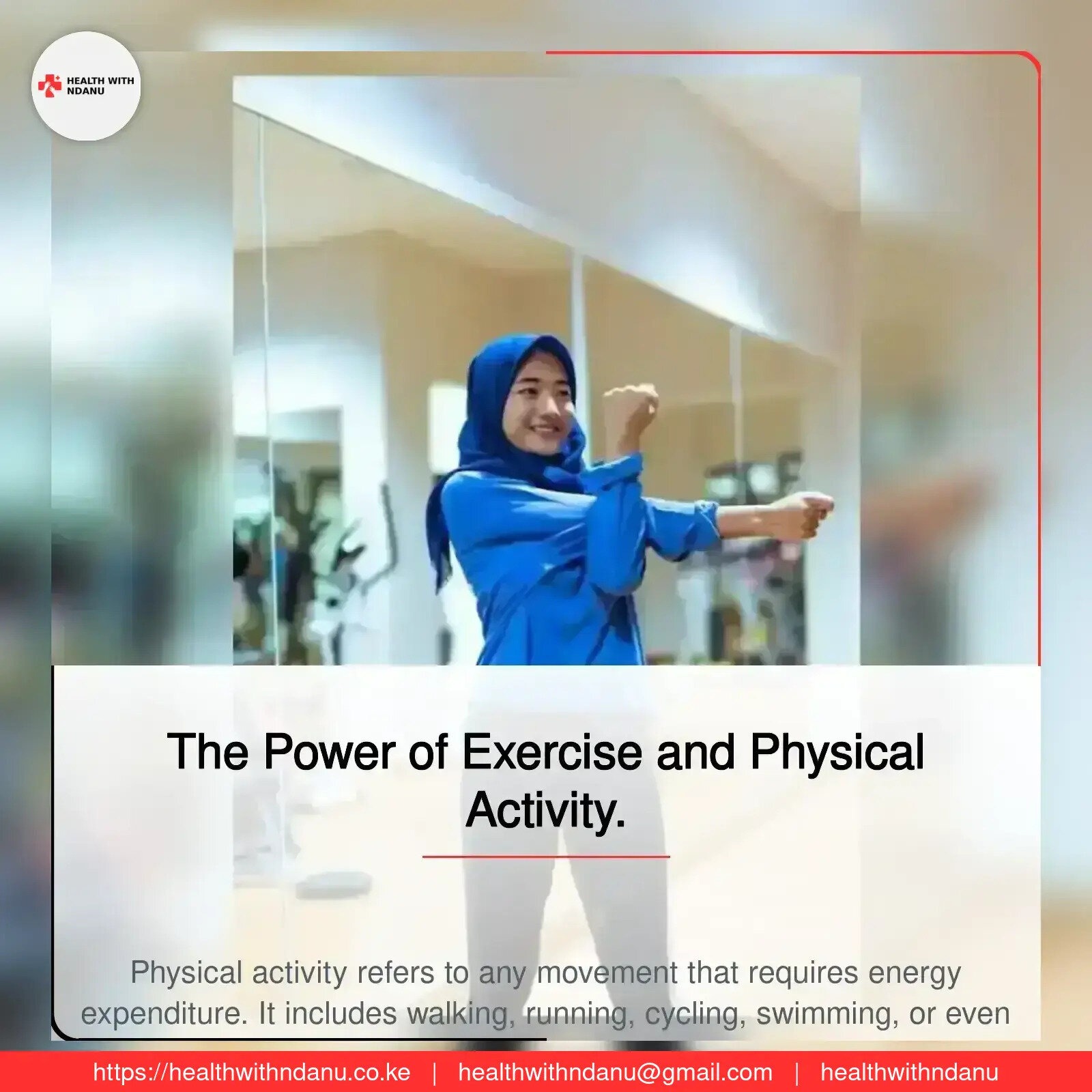The Power of Exercise and Physical Activity.
- by Diana Ndanu
- 03 December, 2024
- 0 Comments
- 7 Mins



Introduction
In today’s fast-paced world, it’s easy to neglect physical health in favor of work, social engagements, or personal obligations. However, one of the most effective ways to improve overall well-being is through regular exercise and physical activity. Not only does staying active help maintain a healthy weight and build strength, but it also plays a crucial role in preventing chronic diseases, improving mental health, and enhancing the quality of life. Whether you’re an athlete or a sedentary individual, engaging in consistent physical activity offers a multitude of benefits.
This article will explore the significance of exercise and physical activity, provide insights into different types of exercises, and offer practical tips for incorporating movement into daily life. By the end, you’ll understand why making exercise a priority is essential for leading a long and healthy life.
1. Understanding the Importance of Physical Activity
Physical activity refers to any movement that requires energy expenditure. It includes activities like walking, running, cycling, swimming, or even housework. On the other hand, exercise is a subset of physical activity that is planned, structured, and repetitive. It is specifically done to improve or maintain physical fitness.
Regular exercise and physical activity are foundational to overall health. The World Health Organization (WHO) recommends that adults engage in at least 150 minutes of moderate-intensity exercise or 75 minutes of vigorous-intensity exercise per week to maintain good health. However, the benefits of exercise extend far beyond weight management and physical fitness.
2. Health Benefits of Exercise and Physical Activity
Engaging in regular exercise and physical activity offers a wide range of physical, mental, and emotional health benefits:
A. Physical Health Benefits
1) Weight Management and Fat Loss: One of the most well-known benefits of exercise is its ability to help with weight management. Regular exercise helps burn calories, leading to fat loss and maintaining a healthy body composition. Combined with a balanced diet, physical activity can support long-term weight loss or maintenance.
2) Improved Cardiovascular Health: Exercise strengthens the heart, improving blood circulation and reducing the risk of heart disease. Activities like jogging, swimming, or cycling improve cardiovascular fitness, lower blood pressure, and reduce the levels of bad cholesterol in the body.
3) Increased Muscle Strength and Flexibility: Strength training exercises such as lifting weights help increase muscle mass, which can prevent the loss of muscle that naturally occurs with aging. Flexibility exercises, like yoga or stretching, help maintain joint health, reduce the risk of injury, and improve overall mobility.
4) Stronger Bones and Joint Health: Weight-bearing exercises, such as walking, running, or strength training, stimulate bone growth and increase bone density, reducing the risk of osteoporosis. Exercise also supports joint health by improving range of motion and maintaining cartilage health.
5) Reduced Risk of Chronic Diseases: Regular physical activity plays a significant role in the prevention and management of chronic conditions, such as type 2 diabetes, stroke, and certain cancers. Exercise helps regulate blood sugar levels, improves insulin sensitivity, and strengthens the immune system.
6) Enhanced Immune Function: Moderate exercise can boost the immune system, making the body more efficient at fighting off infections and illnesses. It improves circulation, allowing immune cells to travel more effectively throughout the body.
B. Mental and Emotional Health Benefits
1. Improved Mood and Reduced Stress: Exercise has been shown to release endorphins, the body’s natural mood elevators. Physical activity helps reduce feelings of stress, anxiety, and depression, making it an effective tool for improving mental health.
2. Boosted Brain Function: Physical activity increases blood flow to the brain, which enhances cognitive function. Regular exercise has been linked to better memory, improved learning abilities, and a reduced risk of cognitive decline and conditions like Alzheimer’s disease.
3. Better Sleep Quality: Regular exercise promotes better sleep patterns. It can help people fall asleep faster, sleep more deeply, and wake up feeling more refreshed. However, it’s important to avoid vigorous exercise too close to bedtime, as it may have the opposite effect.
4. Increased Self-Esteem and Confidence: As you get fitter and stronger, physical activity can boost self-esteem and confidence. Achieving fitness goals, whether they are related to strength, endurance, or flexibility, helps build a positive self-image.
C. Types of Exercise and Their Benefits
There are various types of exercises, each providing unique benefits. Incorporating a variety of exercise forms into your routine ensures that all areas of fitness are addressed. Below are some common categories of exercise:
1) Aerobic (Cardio) Exercise
Aerobic exercise, also known as cardiovascular exercise, involves activities that increase your heart rate and improve the efficiency of the heart and lungs. Examples include:
• Running
• Cycling
• Swimming
• Jumping rope
• Dancing
Benefits of aerobic exercise:
• Improves cardiovascular health
• Boosts lung capacity and endurance
• Burns calories for fat loss
• Reduces the risk of heart disease and stroke
2) Strength Training
Strength training involves exercises that build muscle mass and strength. These exercises typically use weights, resistance bands, or bodyweight. Examples include:
Weight lifting
• Bodyweight exercises (push-ups, squats, lunges)
• Resistance band workouts
Benefits of strength training:
• Builds lean muscle mass and increases strength
• Enhances metabolism and calorie burn
• Strengthens bones and joints
• Improves functional fitness for daily activities
3) Flexibility and Mobility Exercises
Flexibility exercises involve stretching and improving the range of motion in your joints and muscles. Popular examples include:
• Yoga
• Pilates
• Static and dynamic stretching
Benefits of flexibility exercises:
• Improves joint mobility and reduces stiffness
• Prevents injuries
• Enhances posture and balance
• Promotes relaxation and reduces stress
4) Balance and Coordination
Balance exercises help improve stability, coordination, and body control. These are particularly important as we age. Examples include:
• Tai Chi
• Balance drills (standing on one foot)
• Pilates exercises
Benefits of balance and coordination exercises:
• Improves posture and core strength
• Prevents falls and enhances stability
• Promotes better body awareness
4. How to Incorporate Exercise into Your Daily Routine
Incorporating exercise into a busy lifestyle doesn’t have to be difficult. Here are some practical tips to help you stay active throughout the day:
a) Start small: If you’re new to exercise, begin with short, manageable sessions. Gradually increase the duration and intensity as your fitness improves.
b) Make it a habit: Schedule exercise sessions at the same time each day to build a consistent routine. Treat it like an important appointment that cannot be missed.
c) Find activities you enjoy: Exercise shouldn’t feel like a chore. Choose activities you enjoy, whether it’s dancing, hiking, or playing a sport, to make staying active fun and engaging.
d) Incorporate movement throughout the day: If you don’t have time for a structured workout, try incorporating more movement into your daily routine. Take the stairs instead of the elevator, walk or bike instead of driving, or perform stretches during your work breaks.
e ) Set realistic goals: Establish fitness goals that are specific, measurable, and achievable. Tracking your progress will help keep you motivated and focused on improvement.
5. Overcoming Barriers to Exercise
Despite knowing the importance of physical activity, many people face barriers to exercise. Here are common obstacles and solutions:
• Lack of time: Schedule exercise sessions in advance and treat them like appointments. Even 20-30 minutes of exercise is beneficial.
• Lack of motivation: Find an exercise buddy or join a group fitness class to stay motivated. Setting goals and tracking progress can also boost motivation.
• Physical limitations: If you have health concerns or injuries, consult with a healthcare provider to develop a safe and effective exercise plan. Start with low-impact exercises, such as swimming or walking.
Conclusion
Exercise and physical activity are essential for maintaining physical health, improving mental well-being, and enhancing overall quality of life. Regular engagement in aerobic and strength-training exercises, coupled with flexibility and balance workouts, can help prevent chronic conditions, boost energy levels, and improve mood. By incorporating physical activity into your daily routine, you can unlock the numerous benefits that come with leading an active lifestyle.
Remember, the key to successful long-term fitness is consistency. Whether you're a beginner or a seasoned athlete, staying committed to exercise and physical activity is one of the best investments you can make in your health. Start today, and experience the transformative power of exercise in your life.
Got Your Own Experience? Share with us
Popular Categories
Mablogu Zinazobambwa Sana
Daily Newsletter
Get all the top stories from Blogs to keep track.



